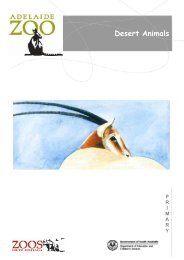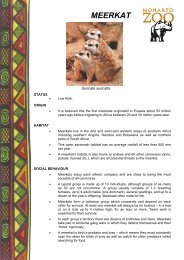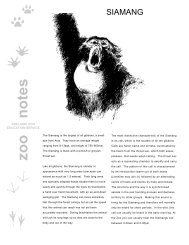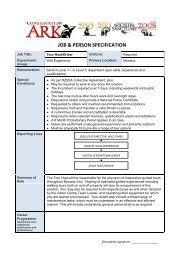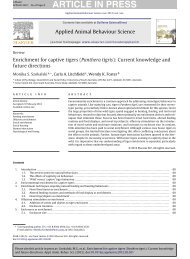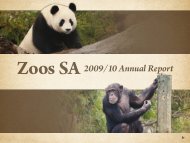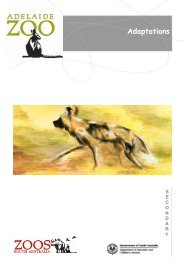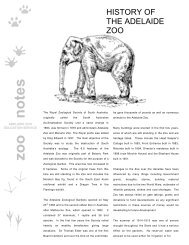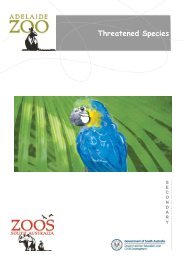2008 - 2009 Annual Report - Zoos South Australia
2008 - 2009 Annual Report - Zoos South Australia
2008 - 2009 Annual Report - Zoos South Australia
- No tags were found...
You also want an ePaper? Increase the reach of your titles
YUMPU automatically turns print PDFs into web optimized ePapers that Google loves.
CONTENTSYear In ReviewPresident and CEO’s <strong>Report</strong>Conservation ProgramsConservation ArkVeterinary Conservation ProgramsAssets and InfrastructureConservation EducationThe AnimalsLiving collectionsThreatened SpeciesOperationsCommunications and PartnershipsVisitor ExperiencesHuman ResourcesFinancial <strong>Report</strong>FinalsThe contributions of the long-term research into <strong>South</strong>ernhairy-nosed wombats to conservation were recognized thisyear with an ARAZPA research award, so congratulations toDr David Taggart and his team of researchers. This year theycompleted surveys on the Yorke Peninsula to identify existingwombat colony sites and the likely size of the colonies, aswell as mapping warren density and distribution in theMurraylands using satellite imagery. Two student projectsinto wombat biology were also completed.Another project has investigated the lives of wild echidnasfound within Monarto Zoo. Also close to Monarto is Ferris-Macdonald Conservation Park which is home to a small groupof Mallee fowl. Several staff were involved in visiting the parkand collecting Mallee fowl eggs from the large vegetationmounds the birds use as nests, and then incubating these atAdelaide Zoo. Three chicks now join others in the collection,and it is intended to start captive breeding when theybecome sexually mature.Other work with birds is also occurring with the long-termpelican study at Outer Harbour continuing and expandingto better understand the effect of fisheries on Black-facedcormorants. In the lab work is being conducted to understandcarotenoids in birds; their metabolic pathways, the role ofmaternal and dietary carotenoids and their role in colourationand breeding.Conservation PsychologyAddressing human consumption patterns is a critical partof conservation as, without doing so, much on-groundconservation work will be in vain as climate change andpollution create dramatic changes in the landscape. Eventoday, events that were thought of as once in 100 year eventsare becoming standard with devastating effects. Withouta change in the way we humans think and behave thecontinued existence of many species remains tenuous.With this in mind, Conservation Ark is developing itsconservation psychology activities. Conservation psychologyis a relatively new field that aims to discover how to changenon-sustainable human behaviour in order to protect thenatural environment and conserve diminishing naturalresources. It draws principles from all areas of psychology,and facilitates collaboration with practitioners from otherfields including ecology, biology and social science.Several projects have been looking at people’s conservationknowledge, as well as attitudes and behaviours. Work isbeing undertaken looking at the impact of viewing a Keeperfeed of Wild dogs, and different experiences with Orangutansand tigers. Research into the impact of a Cheetahencounter at Monarto found people showed an increasein Cheetah knowledge, but no change in pro-conservationattitudes (which were already high initially). Importantly nobehavioural indicators of stress were observed in the animalsparticipating in the encounter either.Conservation and research – 5 of 8



